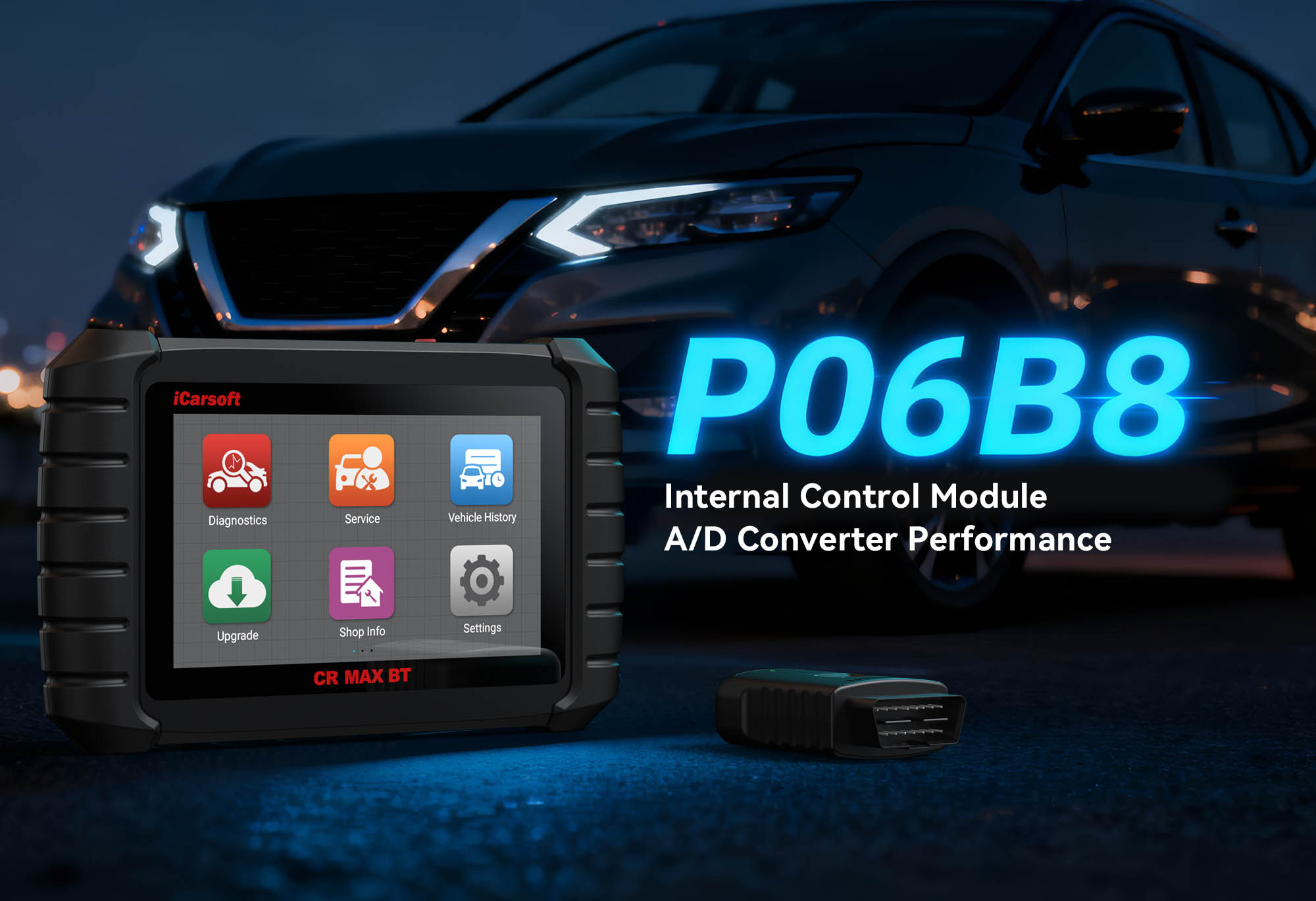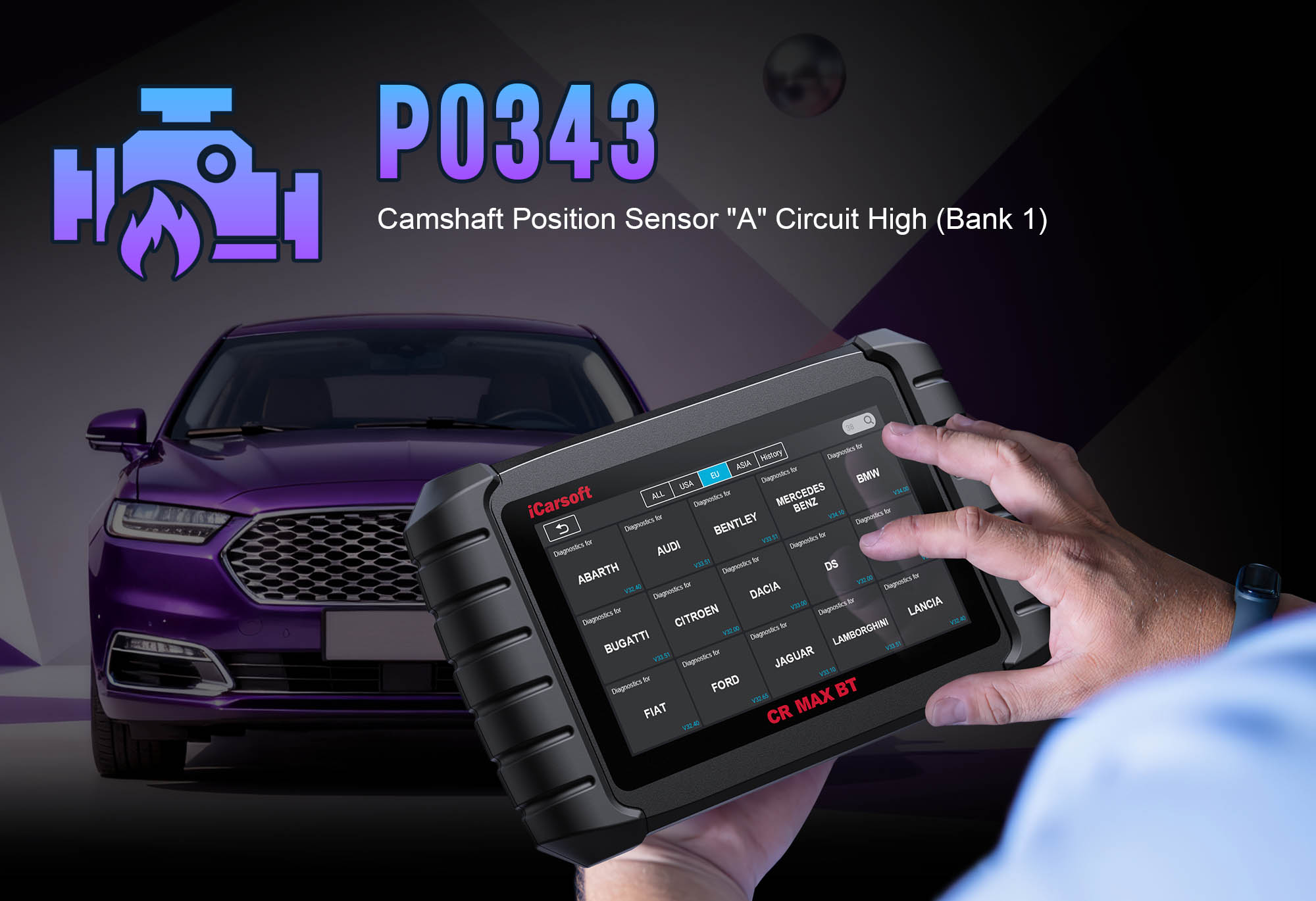Master P0627: Fuel Pump Control Module Voltage High – Fix with iCarsoft CR MAX BT
If your vehicle’s Check Engine Light (CEL) flashes, you experience sudden stalling, or the engine refuses to start, a diagnostic scan will likely return P0627. This critical OBD-II code signals "Fuel Pump Control Module (FPCM) Circuit High Voltage," meaning the Engine Control Module (ECM) has detected an abnormally high voltage (exceeding 16V in most models) in the circuit connecting the ECM to the FPCM. The FPCM regulates fuel pump operation—too much voltage can burn out the pump, damage the module, or leave you stranded with a no-start condition.
Basic code readers only confirm "P0627 is present" but can’t tell if the issue is a faulty FPCM, wiring short, or bad voltage regulator. The iCarsoft CR MAX BT changes the game. As a professional-grade wireless diagnostic tool, it offers real-time voltage monitoring, FPCM activation tests, and compatibility with 58+ vehicle brands—making it the go-to solution for resolving P0627 in popular models like the Dodge Ram 1500, Ford Explorer, Chevrolet Malibu, and Honda Accord. Let’s break down everything you need to fix P0627 confidently.
 iCarsoft CR MAX BT monitoring FPCM circuit voltage to diagnose P0627
iCarsoft CR MAX BT monitoring FPCM circuit voltage to diagnose P0627
What Exactly Is the P0627 Code?
P0627 targets the fuel pump control module (FPCM) and its associated wiring. The FPCM acts as a "middleman" between the ECM and the fuel pump: it receives low-voltage signals from the ECM to adjust fuel pump speed (matching engine demand) and sends status data back. A healthy FPCM circuit operates at 12V–14.5V (typical vehicle battery/alternator voltage). When the ECM detects voltage above the manufacturer’s threshold (often 16V), it triggers P0627 to protect the fuel pump and electrical components.
P0627 is often model-specific: Dodge Ram 1500 P0627 frequently stems from FPCM water damage (common in trucks used for off-roading), while Ford Explorer P0627 may link to a shorted alternator voltage regulator. The iCarsoft CR MAX BT uses Auto VIN technology to pull your vehicle’s exact FPCM voltage specs, eliminating guesswork and pinpointing the root cause fast.
Key Symptoms of the P0627 Code
P0627 symptoms range from mild performance issues to complete engine failure. Watch for these critical red flags:
-
Illuminated Check Engine Light (CEL): The primary warning—often paired with a "Fuel System Fault" message on modern dashboards.
-
Sudden Stalling: The FPCM shuts down the fuel pump to avoid damage, causing the engine to cut out while driving (a major safety hazard).
-
No-Start Condition: High voltage damages the FPCM or fuel pump, leaving the engine without fuel and unable to crank.
-
Reduced Fuel Efficiency: Erratic FPCM operation disrupts fuel delivery, leading to 10–15% higher fuel consumption.
-
Burning Smell: Overheated wiring or a failing FPCM emits a burnt plastic odor—stop driving immediately if you notice this.
Common Causes of the P0627 Code
P0627 arises from issues that push voltage above the FPCM’s safe range. Here are the most likely culprits, ordered by frequency:
|
Cause
|
Description
|
|
Faulty Alternator Voltage Regulator
|
A failing regulator allows the alternator to output excess voltage (16V+), overwhelming the FPCM—top cause of P0627 in all vehicles.
|
|
Shorted Wiring in FPCM Circuit
|
Damaged wires (chewed by rodents, frayed from vibration) create a direct short to the battery’s positive terminal, spiking voltage.
|
|
Failed Fuel Pump Control Module
|
Internal electrical breakdown in the FPCM causes voltage to back up—common in high-mileage P0627 vehicles (100,000+ miles).
|
|
Bad Battery Connections
|
Corroded or loose battery terminals disrupt voltage flow, triggering false high-voltage readings in the FPCM circuit.
|
|
ECM Software Glitch
|
Outdated firmware misinterprets normal voltage fluctuations as "high voltage." The CR MAX BT’s One-Key Upgrade fixes this with free OEM updates.
|
Why iCarsoft CR MAX BT Is Ideal for P0627 Diagnostics
Resolving P0627 requires testing FPCM circuit voltage, module functionality, and related components—something basic scanners can’t do. The CR MAX BT stands out with fuel-system-specific features:
Real-Time FPCM Voltage Monitoring
Track circuit voltage in text or graph form—spot spikes above 16V (the P0627 threshold) in seconds, even during driving.
FPCM Activation Tests
Send commands to the FPCM to activate the fuel pump—verifies if the module responds correctly (3x faster than manual testing).
Alternator Voltage Validation
Measure alternator output to confirm if a faulty regulator is causing high voltage (saves $300+ on unnecessary FPCM replacements).
Auto VIN Identification
Automatically detect your vehicle’s FPCM voltage specs (e.g., Ford’s 12.5V–14.7V range) for accurate diagnostics.
58-Brand Compatibility
Works with all makes prone to P0627, from trucks (Dodge Ram) to sedans (Chevrolet Malibu) and imports (Honda Accord).
Free Lifetime Updates
Stay ahead of 2024+ model FPCM firmware and voltage standards—critical for resolving software-related P0627 false codes.
Step-by-Step: Diagnose & Fix P0627 with iCarsoft CR MAX BT
-
1. Confirm P0627 & Basic Electrical Checks
1. First, check battery terminals (clean corrosion with a wire brush) and ensure the alternator belt is tight.
2. Plug the CR MAX BT’s OBD-II adapter into your vehicle’s port and pair via Bluetooth (7-inch touchscreen connects in 10 seconds).
3. Select Auto VIN Identify to pull vehicle-specific specs, then go to Engine > Fault Codes > Read Codes to confirm P0627.
4. Tap Code Details for insights—e.g., "Dodge Ram 1500: P0627 FPCM Voltage High; 17.2V Detected (Normal: 12.5V–14.7V); Check Alternator/FPCM."
-
2. Monitor FPCM & Alternator Voltage
Start the engine and navigate to Engine > Live Data > Fuel System. Monitor these metrics while idling and revving to 2,000 RPM:
- FPCM Circuit Voltage: Normal = 12V–14.5V. Over 16V = high voltage (confirm P0627 cause).
- Alternator Output Voltage: Normal = 13.5V–14.7V. Over 15V = faulty voltage regulator (top P0627 trigger).
- FPCM Status: "Active" = module is communicating; "Inactive" = faulty FPCM or wiring issue.
-
3. Run FPCM Activation & Circuit Tests
Go to Special Functions > Fuel Pump Control. The CR MAX BT will:
- Perform FPCM Activation Test: Sends a low-voltage signal to the FPCM to start the fuel pump. If the pump doesn’t activate, the FPCM or pump is faulty.
- Run Circuit Continuity Test: Checks for shorts in FPCM wiring—"Short to Positive" result confirms frayed wires (common in off-road vehicles).
-
4. Inspect FPCM & Wiring
1. Locate the FPCM (typically under the rear seat, in the trunk, or near the fuel tank).
2. Use the CR MAX BT’s Multimeter Function to test wiring:
- Disconnect the FPCM connector and test for voltage at the power pin—12V = normal; 16V+ = alternator/regulator issue.
- Check for water damage (rust, corrosion) on the FPCM—common in Ford Explorer P0627 models with rear cargo area leaks.
-
5. Repair & Validate the Fix
Fix based on results:
- Faulty alternator regulator: Replace the alternator (use the CR MAX BT to verify output post-repair).
- Shorted wiring: Repair frayed wires with heat-shrink tubing or replace the harness.
- Failed FPCM: Install an OEM module (use the CR MAX BT’s Module Coding to program it to your vehicle).
1. Clear P0627 via Fault Codes > Clear Codes, then test drive for 50 miles.
2. Re-scan with the CR MAX BT—stable voltage (12V–14.5V) and no error codes confirm success.
FAQs: Your P0627 Questions Answered
Q: Is it safe to drive with the P0627 code?
A: No—P0627 increases the risk of sudden stalling or fire (from overheated wiring). If you must drive, keep it under 5 miles to reach a repair shop, and avoid highways.
Q: How much does it cost to fix P0627?
A: Costs vary:
- Alternator replacement: $300–$600 (parts + labor).
- FPCM replacement: $400–$800 (OEM) + $100–$200 programming.
- Wiring repair: $80–$150.
The CR MAX BT saves $200+ on dealership diagnostics and avoids unnecessary FPCM swaps.
Q: Why does P0627 come back after alternator replacement?
A: You missed a shorted FPCM wire or faulty FPCM. Use the CR MAX BT’s circuit continuity test to find hidden shorts—even a small frayed wire can retrigger P0627.
Q: Can a dead battery cause P0627?
A: Indirectly— a weak battery forces the alternator to overwork, damaging the voltage regulator and causing high voltage. Replace the battery and test the alternator with the CR MAX BT to resolve P0627.
Q: Does P0627 affect hybrid vehicles?
A: Yes—hybrids (e.g., Toyota Prius) have FPCMs for their auxiliary fuel pumps. The CR MAX BT’s hybrid-specific tools handle hybrid P0627 cases by testing high-voltage systems safely.
Q: Will P0627 cause a failed emissions test?
A: Yes—disrupted fuel delivery leads to incomplete combustion, increasing hydrocarbons (HC) and carbon monoxide (CO) emissions. Fix P0627 with the CR MAX BT to ensure compliance.
Conclusion
The P0627 code’s "high voltage" warning is a critical alert for your fuel system—but misdiagnosing it doesn’t have to drain your wallet. The iCarsoft CR MAX BT simplifies P0627 diagnostics with real-time voltage monitoring, FPCM activation tests, and module coding—whether you’re fixing a Dodge Ram 1500 or Honda Accord.
Don’t let a faulty voltage regulator or FPCM leave you stranded. Invest in the CR MAX BT today to diagnose, fix, and maintain your vehicle’s fuel system with professional confidence.

 iCarsoft CR MAX BT monitoring FPCM circuit voltage to diagnose P0627
iCarsoft CR MAX BT monitoring FPCM circuit voltage to diagnose P0627



